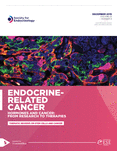Future perspectives of selective estrogen receptor modulators used alone and in combination with DHEA
- Molecular Endocrinology and Oncology Research Center, Laval University Hospital Research Center (CRCHUL) and Laval University, 2705, Laurier Boulevard, Quebec City, Quebec G1V 4G2, Canada
- (Requests for offprints should be addressed to F Labrie; Email: fernand.labrie{at}crchul.ulaval.ca)
Abstract
Breast cancer is the most frequently diagnosed and the second cause of cancer death in women, thus making breast cancer a most feared disease. Since breast cancer metastasizes early and it is unlikely that improvements in the treatment of metastatic disease could permit a cure in most cases in the foreseeable future, it is clear that prevention is essential in order practically to eliminate deaths from breast cancer. Tamoxifen is the only selective estrogen receptor modulator (SERM) currently registered for use in breast cancer prevention; the tamoxifen versus raloxifene study should indicate the efficacy of this compound compared with raloxifene. The recent benefits of aromatase inhibitors over tamoxifen indicate the advantages of a blockade of estrogens more complete than the one achieved with tamoxifen, a SERM having some estrogenic activity in the mammary gland and an even higher estrogenic action in the uterus. However, it is unlikely that the general estrogen ablation achieved with aromatase inhibitors will be acceptable for the long-term use required for prevention. It is thus important to develop SERMs with highly potent and pure antagonistic activity in the mammary gland and uterus while possessing estrogen-like activity in tissues of particular importance for women’s health, namely the bones and the cardiovascular system. However, it is expected that a SERM alone will not meet all the requirements of women’s health at the postmenopause when ovarian estrogen secretion has ceased and peripheral formation of androgens and estrogens from DHEA by intracrine mechanisms is decreased by 60% or more. One possibility is to combine a SERM with DHEA, a precursor of sex steroids that permits, somewhat like SERMs, tissue-specific formation of androgens and/or estrogens according to the level of expression of the steroidogenic and steroid-inactivating enzymes. DHEA could thus compensate for the important loss of androgens that accompanies aging and could also permit sex steroid formation and action in the brain while breast cancer prevention would be achieved by the SERM.
- © 2006 Society for Endocrinology














